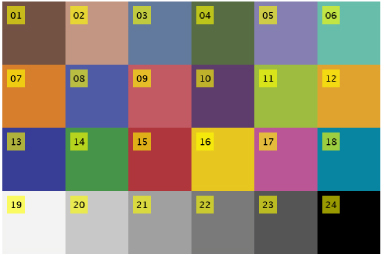Acknowledgment
The mention of commercial products, their sources, or their use in connection with material reported herein is not to be construed as either an actual or implied endorsement of such products by the Department of Health and Human Services. This is a contribution of the U.S. Food and Drug Administration and is not subject to copyright.
The author thanks Andrew Fales, Eshan Dahal, Andreu Badal-Soler, and the anynomous reviewers for reviewing the software and the manuscript. The author thanks the members of the Color Performance Review team, Ryan Beams, Paul Lemaillet, Andreu Badal-Soler, Andrea Kim, Eshan Dahal, Andrew Fales, and Quanzeng Wang, for their work on endoscopy device review.
References
1OgilvieJ.HicksL. M.KallooA.Johns Hopkins Manual of Gastrointestinal Endoscopic Procedures2008SLACK IncorporatedThorofare, NJ
2IddanG.MeronG.GlukhovskyA.SwainP.2000Wireless capsule endoscopyNature405417417417–10.1038/35013140
3FisherM.MackiewiczM.2013Colour image analysis of wireless capsule endoscopy video: A reviewColor Medical Image Analysis129144129–44SpringerDordrecht
4AshourA. S.DeyN.MohamedW. S.TrompJ. G.SherrattR. S.ShiF.MoraruL.2020Colored video analysis in wireless capsule endoscopy: a survey of state-of-the-artCurr. Med. Imaging16107410841074–8410.2174/1573405616666200124140915
5ThanT. D.AliciG.ZhouH.LiW.2012A review of localization systems for robotic endoscopic capsulesIEEE Trans. Biomed. Eng.59238723992387–9910.1109/TBME.2012.2201715
6DohiO.YagiN.OnozawaY.Kimura-TsuchiyaR.MajimaA.KitaichiT.HoriiY.SuzukiK.TomieA.OkayamaT.YoshidaN.2016Linked color imaging improves endoscopic diagnosis of active Helicobacter pylori infectionJ. Gastroenterol. Hepatol.31281281281–10.1111/jgh.13114
7KanzakiH.TakenakaR.KawaharaY.KawaiD.ObayashiY.BabaY.SakaeH.GotodaT.KonoY.MiuraK.IwamuroM.2017Linked color imaging (LCI), a novel image-enhanced endoscopy technology, emphasizes the color of early gastric cancerEndoscopy Int. Open5E1005E1013E1005–1310.1055/s-0043-117881
8De GroenP. C.2017History of the endoscope [scanning our past]Proc. IEEE105198719951987–9510.1109/JPROC.2017.2742858
9EdmonsonJ. M.1991History of the instruments for gastrointestinal endoscopyGastrointest. Endosc.37S27S56S27–5610.1016/S0016-5107(91)70910-3
10ClassenM.PhillipJ.1984Electronic endoscopy of the gastrointestinal tractEndoscopy16161916–910.1055/s-2007-1018518
11ClassenM.KnyrimK.SeidlitzH.HagenmüllerF.1987Electronic endoscopy—the latest technologyEndoscopy19118123118–2310.1055/s-2007-1018255
12KnyrimK.SeidlitzH.HagenmüllerF.ClassenM.1987Color performance of video endoscopes: quantitative measurement of color reproductionEndoscopy19233236233–610.1055/s-2007-1018290
13KnyrimK.SeidlitzH.HagenmüllerF.ClassenM.1987Video-endoscopes in comparison with fiberscopes: quantitative measurement of optical resolutionEndoscopy19156159156–910.1055/s-2007-1018268
14VakilN.KnyrimK.EverbachE. C.1991The appreciation of colour in endoscopyBaillière’s Clin. Gastroenterol.5183194183–9410.1016/0950-3528(91)90011-O
15TaylorJ. M.PiccianoL. D.1994Color imaging in endoscopy perspectives and new directionsProc. IS&T/SID CIC2: Second Color Imaging Conf.196199196–9Springfield, VA
16ConstantinouI.NeofytouM.TanosV.PattichisM.ChristodoulouC.PattichisC.2013A comparison of color correction algorithms for endoscopic camerasIEEE 13th Int’l. Conf. Bioinformatics and Bioengineering (BIBE)IEEEPiscataway, NJ10.1109/BIBE.2013.6701631
17KamarudinN. D.RusliM. S.YeeO. C.MansoorS. B. R. S.AzahariA. M.ZainolZ.Abd GhaniK.MakhtarS. N.2018Performance comparison of colour correction and colour grading algorithm for medical imaging applicationsInt. J. Eng. Technol.7353356353–6
18GeleijnseG.HakkesteegtM.de GrootJ.MetselaarR.2021Measuring image quality of ENT chip-on-tip endoscopesJ. Imaging Sci. Technol.6520503-120503-720503-1–710.2352/J.ImagingSci.Technol.2021.65.2.020503
19GeleijnseG.VederL.HakkesteegtM.MetselaarR.
201999International Electrotechnical CommissionGeneva, Switzerland
21
22

 Find this author on Google Scholar
Find this author on Google Scholar Find this author on PubMed
Find this author on PubMed
 Open access
Open access